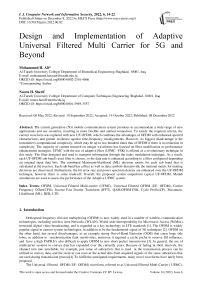Design and Implementation of Adaptive Universal Filtered Multi Carrier for 5G and Beyond
Автор: Mohammed H. Ali, Noora H. Sherif
Журнал: International Journal of Computer Network and Information Security @ijcnis
Статья в выпуске: 6 vol.14, 2022 года.
Бесплатный доступ
The current generation (5G) mobile communication system promises to accommodate a wide range of new applications and use scenarios, resulting in more flexible and unified connection. To satisfy the required criteria, the current waveform was replaced with new UF-OFDM, which combines the advantages of OFDM with enhanced spectral characteristics and greater resilience against time-frequency misalignments. However, its biggest disadvantage is the transmitter's computational complexity, which may be up to two hundred times that of OFDM if there is no reduction in complexity. The majority of current research on unique waveforms has focused on filter modification or performance enhancement strategies. UFMC with the use of adaptive filter (UFMC -FSK) is offered as a revolutionary technique in this study. The filter designed and used to transport information through the index modulation technique. As a result, each UF-OFDM sub band's used filter is chosen, so the data rate is enhanced according to a filter configured depending on original input data bits. The combined Maximum-likelihood (ML) decision metric for each sub band that is calculated at the receiver. Each sub band has a filter as well as data symbols that provide the minimal metric for making decisions are discovered. Furthermore, the bit error rate and power spectrum density are enhanced over the UF-OFDM technique, however there is some trade-off. Overall, the proposed system outperform typical UF-OFDM. Matlab simulations are used to assess the performance of the Adaptive UFMC system.
OFDM, Universal Filtered Multi-carrier (UFMC), Universal Filtered OFDM (UF- OFDM), Carrier Frequency Offset(CFO), Inverse Fast Fourier Transform (IFFT), QAM, OFDM-FSK, Cycle Prefix(CP), Maximum-Likelihood (ML), BER, LTE
Короткий адрес: https://sciup.org/15018552
IDR: 15018552 | DOI: 10.5815/ijcnis.2022.06.02
Текст научной статьи Design and Implementation of Adaptive Universal Filtered Multi Carrier for 5G and Beyond
Orthogonal frequency division multiplexing (OFDM) is now widely used in a number of wireless communication technologies, including wireless Area Networks (WLAN), World wide Interoperability for Microwave Access (WiMax), terrestrial digital video broadcasting, and is regarded as a key technology in LTE standards [1]. The OFDM is widely popular signal in current system technologies, in addition to be the fundamental signal of 5G techniques [2]. OFDM on the other hand, has several disadvantages, as an example strong Out-of-Band Emission (OOB) that cause huge side lobes, in addition to synchronization fault sensitivities, moreover it required a cyclic prefix to remove ISI influence, and have a high PAPR.It's also difficult to apply OFDM in new short-packet transmission [3]. In general, the use of multicarrier systems to convey data has expanded over the currently years. Because of fading in short intervals, the channel turn into unreliable, for example, just some of subcarriers that is used in the transmission process can be utilized to convey data, and the receiver can recover the actual data from acquired signals of the same subcarriers that are used during transmission process[4].To fulfill the anticipated requirements, many novel waveforms have lately been proposed.
The Universal -Filtered OFDM (UF- OFDM) waveform, referred to as Universal Filtered Multi-Carrier ( UFMC), as among the most powerful waveforms [2]. UFMC is more resistant to real-time delays than OFDM. Filtering process in terms of sub bands, that is done using FIR, is the fundamental distinction between UF-OFDM and the OFDM waveform.
Every subband is thought of as a separate Resources Block (RB), which consists of a collection of continuous subcarriers.
Following that, each sub band is filtered using a distinct FIR Filter after performing the inverse Fast Fourier transform (IFFT) process. This approach enhances carrier frequency offset (CFO) resilience as well as its applicability for strategy of short-packet transmitting techniques [5]. CFO significantly reduces the strength of the received signal. Because coherent detection is impacted by CFO comparing with non coherent detection, the detection mechanism at the receive part plays an important role in CFO reduction. CFO, if not accurately calculated, reduces BER in any channel [6]. Because of these benefits, UF-OFDM is being considered as a potential signals that capable of addressing the liitations of OFDM , and will be used in 5G and after the 5G.
New research on innovative waveforms has concentrated on optimizing error performance through filter change or the addition of supporting techniques. Such scenarios, unfortunately, do not taking into consideration performance any rate of transmission improvements, as the capacity requirements of 5G technologies have still yet to be realized. An adaptive UF-OFDM with FSK system is given as a solution to this basic issue. OFDM with IM is a technology that combines OFDM with index modulation [7], and practically carried out[8]. Extra data bits are broadcast in addition to the regular data symbols when active subcarrier indices are selected. Compared to OFDM, this transmission technique provides a lot of benefits [9]. The process of sub band-wise smoothing is regarded as a data transfer technique. as a result of this approach [10]. OFDM with filter, at both transmitter and beneficiary side gives a steady BER for all SNR. Therefore, OFDM with filter at transmitter is more efficient [11]. Universal Filtered Multi Carrier (UFMC) was developed as a novel waveform design that represents an extension of the idea with the goal of capturing the benefits while avoiding the drawbacks. Filtering is done on a per-sub band basis with UFMC. The block diagram which include whole transceiver sequence in UL is shown in Figure 1.
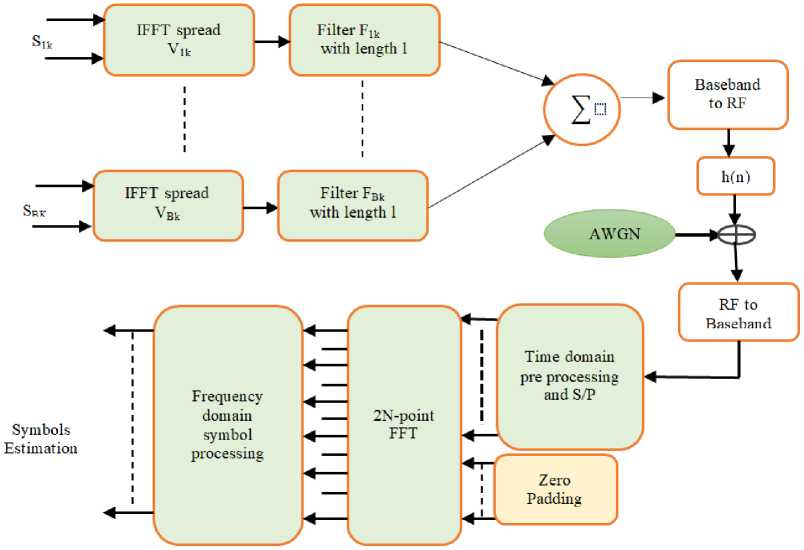
Fig.1. UFMC system
For a given multicarrier symbol of user k, the time domain transmit vector X(k) is the combinations of the subband wise filtered components, with filter length l and FFT length N (we ignore the time index m for simplicity), and the UFMC signal can be expressed in both matrix and vector form. [10]:
X(k) = Z f=i Flk [(v+l-i)^^] ^[jv-mi]] S ik^ Z],
The IFFT-matrix V ik transforms, then complicated QAM symbols obtained in S ik to time domain for each of the B sub-bands, indexed i. V ik includes the necessary columns of the inverse Fourier matrix according on the location of the corresponding sub-band within the overall accessible range. A range of frequencies F ik is a Toeplitz matrix that contains the filter impulse response and performs convolution[12].
The aggregate signal is up-converted and RF treated after superposition. All user communications are received as a noisy superposition by the detector. After conversion to baseband, the received signal vector may optionally be processed in time domain, e.g. windowing, to suppress multi-user interference, and in frequency domain after FFT conversion (any procedure known for CP-OFDM is applicable here - e.g. related to channel estimation and equalization) to improve signal quality. UFMC is a generalization of conventional CP-OFDM, with the latter being a particular case of the former (with L = 1). As a result, the abbreviation UF-OFDM [13]. UFMC combines the benefits of OFDM and FBMC. UFMC employs subband filtering, which is composed of a number of subcarriers. OOB emittion in UFMC is substantially lower than in OFDM due to the filters utilized. Filtering process of subband decreases the lengths of the filters in UF-OFDM techniques, making it used for transfer short data[14]. Because of the QAM modulation employed at transmitting processr, UFMC is suitable to utlize with MIMO methods.
2. Related Works
The relation between techniques are crucial for better comprehension and use of various technologies. Moreover, to UF-OFDM, which is similar to other OFDM, several waves have been raised in the context of 5G studies activities. One lively waveform is a filter bank multicarrier (FBMC), which combines intelligent subcarrier filtering. Such filtering provides very small side lopes and gives FBMC greater strength against sync errors OFDM [15]. However, long signal tails caused by subcarrier wise filtering, as well as its complexity of use are limited the use of FBMC in real time. Like any other candidate, generalized frequency division multiplexing (GFDM) is suggested in [16]. GFDM has an intelligent network and non-orthogonal filter the local performance of the sub-carriers, and provides low-out-of-band output. This advantage makes GFDM suitable for radio applications like cognitive radio[17].
In [18], the OFDM with filter (F-OFDM) is suggested, similar to the UF-OFDM goal, smart subband filtering also used in F-OFDM, where filter length is permit to cross the length of the cyclic prefix (CP). However, in comparison long signal length limits f-OFDM performance in some 5G situations that require the delivery of short packets. In [19] researchers present studies and comparing of OFDM, GFDM and UF-OFDM in comprehension radio applications. Ideally, the UF-OFDM and GFDM signals provide best performance comparing with OFDM. Similarly, the GFDM, OFDM, FBMC and UF-OFDM waves are tested according to time offset (TO ) in addition to CFO, it is shown that UF-OFDM is also linear FBMC provides excellent performance between these waves. For 5G and beyond applications, the UF-OFDM is rational and excellent effective choice. In [20], the side lob attenuation of the filter is investigated since the UFMC system is crucial to lowering the OOB of the system. So, the performance of the system rises as side lobe attenuation rises.
In [21,22], due to OQAM modulation, the FBMC displayed minimal OOB emission levels, low BER, and the finest spectral efficiency. It is therefore the most appropriate for eMBB and URLLC applications. Moreover, because to its brief transmission burst capability and non-orthogonality. UFMC was found to be appropriate for mMTC applications. For both perfect and imperfect synchronization of frequency between the transmission and reception sides, UFMC performs better than CP-OFDM,and compare the SER performance of the UFMC scheme with that of the OFDM techniques [23].The authors in [24] used light weight IFFT to implement a UFMC transmitter, merging with FIR filter model, in addition to use the poly-phase design filter to minimize the UFMC transmitter's complexity of the algorithm. The authors in [25,26] used large FFT and M-QAM values in UFCM may improve UFCM performance in contexts with parallel processing. In these circumstances, the multiprocessing approaches will reduce the chance of additional computational complexity from the bigger FFT and M-QAM values, and the overall performance will be enhanced. As a result, the 1024-bit QAM scheme approach exhibits better utilization of frequency spectrum utilization. In [27], the authors determines the BER for various transformations, modulations, and coding scheme, and the result indicated that the FFT-based OFDM technique outperforms the DWT-based OFDM technique. Moreover, the efficiency of an OFDM scheme is improved by employing cyclic code rather than linear code. the OFDM technique combining Cyclic coding and BPSK/QPSK modulation provides the lowest BER value. In [28] the odd subcarriers are determined to include interference and are dropped, the even subcarriers are utlized to decode the original data and demonstrate that the transmitted signal's odd subcarriers also carry important information. According onto to this, a prototype receiver of the UFMC technique is developed that uses the LMS requirement to take use of all subcarriers in order to increase performance.
3. Mathematics Model
The Proposed Methodology:
The Proposed system allows us to analyze the OFDM-FSK system’s performance in the presence of Gaussian noise and non Gaussian noise, including synchronization errors. Approach is proposed that improves throughput without sacrificing any of the UF-traditional OFDM's benefits. The selection of correct filter sets that comprise identifiable FIR filters is critical to the success of the UF-OFDM-with-different-filters system. On the receiver side, a simple detector is used to identify the relevant data symbols as well as the FIR filter that provides the lowest cumulative decision metric in sub band. Matlab simulations are used to assess the system's bit error performance.
Figure 2. Shows a block diagram of the adaptive UF-OFDM transmitter. The UF-OFDM transmitter transmit signal consists of n data bits are grouped into D sets of l bits. In traditional UF-OFDM, each group's of data bits are modulated with QAM mapping, and a sub band is produced from these symbols. However, as compared to the traditional UF-OFDM scheme, adaptive UFMC approach allows to the FSK method for the transfer additional data bits l. l bits in the FSK system are made up of l1 information bits modulated to M-QAM scheme, as well as l2 filter shift keying modulating bits.
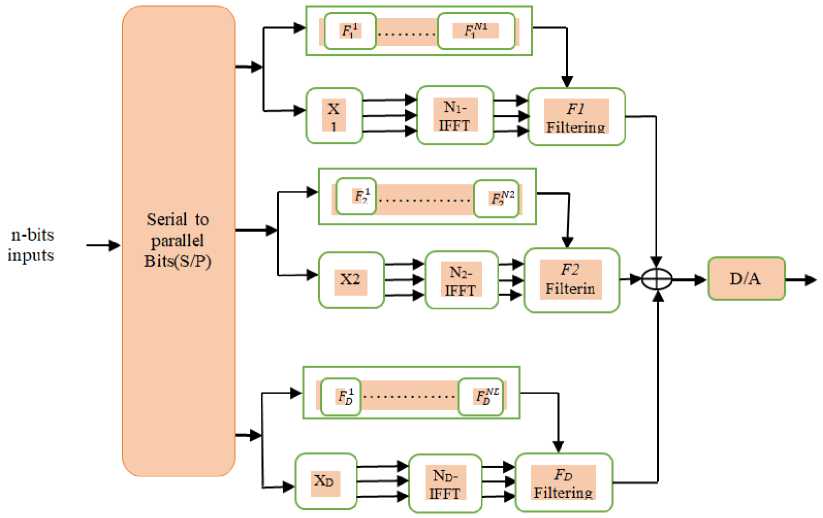
Fig.2. Block diagram of adaptive UFMC transmitter.
The realized finite impulse filter fts which include time domain LP parameters of a prototype filter, obtained from the filter group F i = {ft~f i2....... f^1} , that i =1, 2, . . . ,D . which i is sub band index, and the overall filters accessible is Ni , at the construction of the ith no. of sub band. The set's filters Fi may be chosen as Dolph Chebyshev polynomials filters along with equal L which is the length but with variety of lobes attenuation. The identical filter set is used in all of the procedures. N f denotes the overall number of possible filters, including sub bands, i.e. N1 = N2 = ND = Nf. Furthermore, The UFMC-N f -FSK filter configuration is used to model the AUFMC scheme.
Assume that l 1 bits are Ni all baseband subcarriers. The symbols in the ith sub band is extracted in the time domain through N-point IFFT.
Xi(n)= ^ W Y.[K]
X i [ k ] , is M-QAM symbols in frequency domain,and n, k = {0 , 1, 2,…….., N – 1}
The filtering action is carried by using specified filter fts ,
Xi = XL * fts(3)
* is the circular convolution operator, and the filter's length that is chosen fts is symbol by l .
After that, every sub bands content filtered signal is analyzed, following that are added, then UFMC symbols is acquired as
X = U?=1Xt
The receiver design of A-UFMC is shown in Figure 3. After transmission operation, the receiver receives the signal that was transmitted over the mobile channel in the following manner:
Уи = хи * h№ + z(n)
Where n = 0,1,2 ,
N + l-1
And Z [„] is additive white Gaussian noise (AWGN), and h [ n ] impulse response of the channel. To implement 2N-point FFT, which zero padding is done so the time-domain signal lengths is raised to double N.
Г[к] = IFFT ( y[n])
Detection of transmitted ordinary data bits is done via sub band-wise detection. Sub band-wise approach is utilized to appropriately detect transferred normal bits and as well as filter modulating data bits, in which subcarriers at the relevant sub band indices are gathered and Yi[k] is formed.
Each sub band employs maximum-likelihood (ML) detection process.So that each minimal decision making metric value acquired through ML discovery on the relevant subcarrier that is saved then added together in order to find a filter which gives lowest a metric for making decisions in a specific sub band. Lastly, the detection process is done, this technique may be described mathematical form as follows:
К [кШ5 ]= arg min Z "X] | Yi^k] - H [k]S[r] 1 2
Where Ft5 = FFT (Ft) = [ Ft5[0] Ft5[1] • • • Ft5[7V — 1]], and li is represent the vector index that is including the N D i indices of subcarriers that relevant to sub band. B[r] is the rth symbol of that constellation which is conent in Mi, where Mi is symbols of Mi-QAM constellation used at ith sub band.
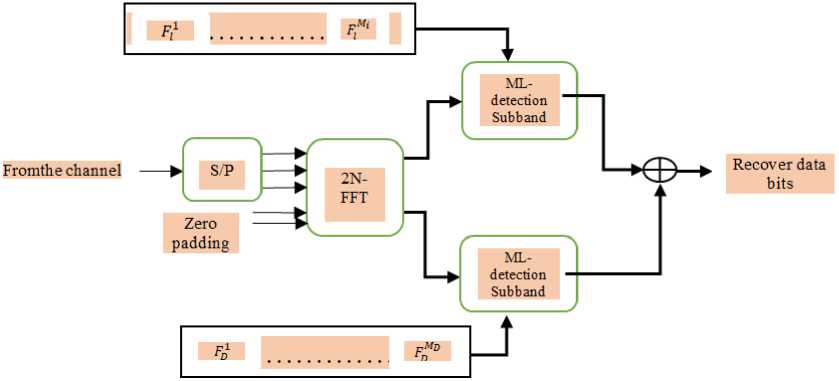
Fig.3. Block diagram of adaptive UFMC receiver.
It's worth noting that all of the sub bands in this research include symbols from the same constellation. It should be noted that all of the sub bands in this method include symbols from the same constellation. Furthermore, Yi[k] and Hi[k] indicate the frequency domain waveforms that are received and the associated coefficient of the channel, respectively. The differentiate of particular filters in F i set determines the detection procedure's effectiveness. This detector takes use of the variations in filter parameters among the available filters before selecting the best one. The filtering process is used as a data transmission source in the development of an UFMC waveform that boosts throughput. A transmission structure has been proposed that is both efficient and practicable.
4. Simulation and Results
This section discusses the suggested waveform's analysis of the adaptive UF-OFDM performance in AWGN using MATLAB program for computer simulations. To study the performance analysis, random data is created and modulated using various modulation techniques such as 4-QAM, 16-QAM, 64-QAM, and 256-QAM. Table 1 gives details of the many parameters utilized in simulations and analyses.
Simulations will be run in accordance with the setup parmeters in Table 1. The Dolph-Chebyshev filter is used in UFMC and has a length of 'l'. The length of the filter is determined by the size of the sub-band, which is the number of carriers in the sub-band. Firstly, the power spectral density values for 160 subcarriers for two scenario can be demonstrated in Figure (4), where the whole band was divided into eight sub-bands, each with 20 subcarriers and the rate of side lobes is lower.Its evident that the filtering operation for each sub-band in A-UFMC, makes the spectral regrowth is quite low (-80 dB) when compared to UF-OFDM (-60 dB). As a result, the out of band level of A-UFMC is lower than the UFMC scenario. Furthermore, it outperforms the standard UFMC system in terms of PSD performance.
Table 1. Simulation parameters
|
Name of Parameter |
Value of Parameter |
|
FFT/IFFT |
265, 512 |
|
Number of sub bands |
10,20,40 |
|
Side lobe levels of filters (dB) |
20,40,80,100 |
|
Modulation type |
16-QAM |
|
Filter length |
73 |
|
Subband size(N D ) |
2,4,8,16 |
|
Filter Type |
Dolph Chebyshev |
|
Zero padding |
76 |
|
Bits per Sub-Carriers |
2,4,8,16 |
|
Sampling rates |
2*104sample/sec |
|
Carrier Frequency |
2GHz |

Fig.4. PSD of adaptive UFMC and UFMC.
The performances for both AUF-OFDM and UFMC waveforms in terms of BER and SNR are carried out, and the results for subband sizes, ND = 4, and ND = 16 are presented in Figure 5 and Figure 6. These results also illustrate enhancements of throughput, with various numbers of available filters. Two subband size configurations are investigated to analyze the relation between BER and throughput and discover that trade-off between them. Furthermore, four unique setups available. There really are 2, 4, 8, and 16 filters available, respectively.
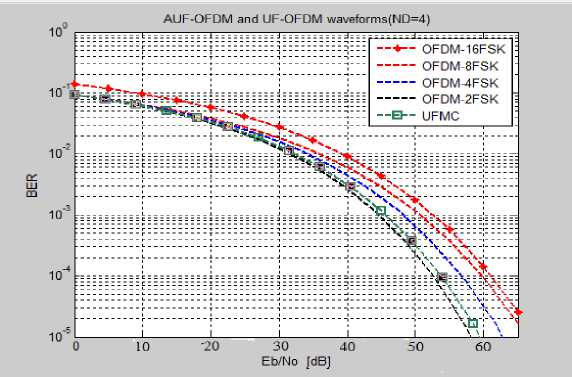
Fig.5. Shows performance of the AUF-OFDM and UFMC signals for ND = Four.
For all four filter size connections, the improved throughput achieved with ND = 16, results in lower BER than with ND = 4. When ND = 4, the BER degrades somewhat with the number of filters increasing from two to sixteen. An suitable BER performance is achieved with a large throughput gain, particularly for two filters as illustrated in Figure 5. Table 2 shows that the values of BER and Bitrates of UFMC and AUFMC scenario at different SNR.
Table 2. BER and Bitrates values(ND=4)
|
Technique |
UFMC |
UFMC-2FSK |
UFMC-16FSK |
|
BER at 35 dB |
6*10-3 |
5*10-3 |
2*10-2 |
|
BER at 40 dB |
2*10-3 |
1*10-3 |
10-2 |
|
Bitrate |
1bit/sec |
1.59 bits/sec |
1.65 bits/sec |
In the Figure 6 when ND is set to 16, acceptable BER and throughput gains over the UF-OFDM waveform are obtained. With a throughput increase, approximately the same performance is attained for two filters. A decent level of throughput gain is attained with four filters. When compared to the other FSK configurations, OFDM- 2-FSK is clearly more robust to channel impairments. When compared to UFMC, the OFDM- 2FSK signal performs comparably with no substantial error performance loss, while also providing a large throughput boost. Table 3 shows that the values of BER and Bitrates of UFMC and AUFMC scenario at different SNR.
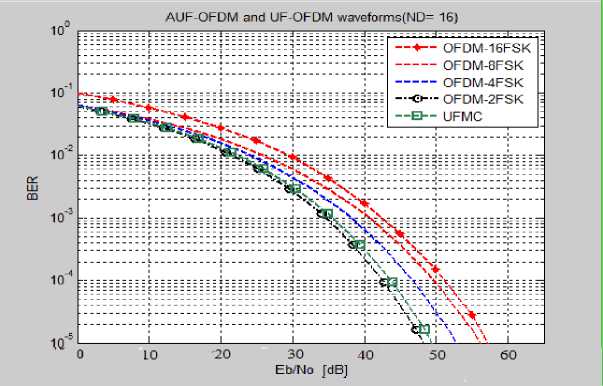
Fig.6. Shows performance of the AUF-OFDM and UFMC signals for ND = sixteen.
Table 3. BER and Bitrates values (ND=16)
|
Technique |
UFMC |
UFMC-2FSK |
UFMC-16FSK |
|
BER at 35 dB |
1.5*10-3 |
1*10-3 |
5*10-3 |
|
BER at 40 dB |
2*10-4 |
1*10-4 |
2*10-3 |
|
Bitrate |
1bit/sec |
1.39 bits/sec |
1.47bits/sec |
5. Conclusions
When the Bit Error Rate (BER) was plotted against various levels of SNR, it was discovered that UFMC outperforms AUF-OFDM in terms of low SNR values for four distinct configurations(filter size), because it does not suffer from the CFO and channel estimation problems that affect the proposed AUFMC scheme, but when SNR increased, especially greater than 30dB, AUF-OFDM generate better results in term BER. 2-FSK with N D = 16 outperforms UF-OFDM in terms of error performance, and when compared to the other FSK configurations, OFDM- 2-FSK is clearly more robust to actual impairments of the channel.So, to boost throughput, an adaptive UFMC waveform has been developed that uses the filtering procedure itself as a wireless data source.
Also conclude that, the throughput enhance that may be achieved with varied numbers of available filters. A modest decrease in BER is observed when the number of filters is increased from two to sixteen. One may get a good throughput improvements while still maintaining an acceptable BER performance using a pair of filters.
As a result, if channel estimation problem becomes prevalent, careful design of the OFDM-FSK scheme may give more reliable bit error rate. So that, this waveform can provide high quality product or service in 5G technology and beyond.
Список литературы Design and Implementation of Adaptive Universal Filtered Multi Carrier for 5G and Beyond
- Y. Qiu, Z. Liu and D. Qu, "Filtered bank based implementation for filtered OFDM," 2017 7th IEEE International Conference on Electronics Information and Emergency Communication (ICEIEC), 2017, pp. 15-18.
- Y. Chen, F. Schaich and T. Wild, "Multiple Access and Waveforms for 5G: IDMA and Universal Filtered Multi-Carrier," 2014 IEEE 79th Vehicular Technology Conference (VTC Spring), 2014, pp. 1-5.
- S M Shamsul Alam, Anamika Saha, " Performance Analysis of FBMC over OFDM for High Data Rate MIMO Configurations", International Journal of Wireless and Microwave Technologies(IJWMT), Vol.11, No.4, pp. 20-33, 2021.DOI:10.5815/ijwmt.2021.04.03
- Amin Naemi, "Detection and Extraction of OFDM Parameters Using Difference of Gaussians", International Journal of Wireless and Microwave Technologies(IJWMT), Vol.9, No.5, pp. 12-24, 2019.DOI:10.5815/ijwmt.2019.05.02
- J. Nadal, “Filtered multicarrier waveforms in the context of 5G : novel algorithms and architecture optimizations To cite this version : HAL Id : tel-01829015 Jérémy Nadal Filtered Multicarrier Waveforms in the Context of 5G : Novel Algorithms and Architecture Optim,” 2018.
- C. D. Parekha and J. M. Patel, “OFDM Synchronization Techniques for 802 . 11ac WLAN,” vol.8, no. 4, pp. 1–13, 2018.
- E. Basar, U. Aygolu, E. Panayirci, and H. V. Poor, “Orthogonal Frequency Division Multiplexing with index modulation,” IEEE Trans. Signal Process. vol. 61, no. 22, pp. 5536–5549, Nov. 2013.
- S. Gokceli, E. Basar, M. Wen, and G. K. Kurt, “Practical Implementation of Index Mod. on - based waveforms,” IEEE Access, vol. 5, no. 1, pp. 25 463–25 473, Dec. 2017.
- M. Wen, X. Cheng, and L. Yang, “Index Modulation for 5G Wireless Communications,” Springer. AG2017, p. 154, 2017.
- T. Wild and F. Schaich, "A Reduced Complexity Transmitter for UF-OFDM," 2015 IEEE 81st Vehicular Technology Conference (VTC Spring), pp. 1-6, May,2015.
- M. Hussein Ali, N. Hani, and D. Jassim“ Design and Implementation of OFDM system with Energy Detection Spectrum Sensing for Cognitive Radio Networks Using HDL Coder Technique” Journal of Al-Turath University College Vol.2, issue 30, pp.94-105,2020.
- G. Wunder, M. Kasparick, T. Wild, F. Schaich, Y. Chen, S. t. Brink, et al., “5GNOW: Application Challenges and Initial Waveform Results “, Proceedings of Future Network & Mobile Summit 2013, Lisbon, July 2013.
- F. Schaich, T. Wild, Y. Chen “Waveform contenders for 5G – suitability for short packet and low latency transmissions” Bell Labs Stuttgart, Germany,2015.
- T. Wild, F. Schaich and Y. Chen, "5G air interface design based on Universal Filtered (UF-)OFDM," 2014 19th International Conference on Digital Signal Processing, 2014, pp. 699-704.
- B. Farhang-boroujeny, “Filter Bank Multicarrier Modulation : A Waveform Candidate for 5G and Beyond,” vol. 2014, 2014.
- R. Datta, N. Michailow, M. Lentmaier, and G. Fettweis, “GFDM interference cancellation for flexible cognitive radio phy design,” IEEE Veh. Technol. Conf., 2012.
- M. Danneberg, R. Datta, A. Festag and G. Fettweis, "Experimental testbed for 5G cognitive radio access in 4G LTE cellular systems," 2014 IEEE 8th Sensor Array and Multichannel Signal Processing Workshop (SAM), 2014, pp. 321-324.
- A. Amijavaheri, A. Farhng, A. RezzadehReyhani, and B. Farhang Borujeny, Impact of timing and frequency offsets on multicarrier waveform candidates for 5G,” in Proc. 2015 IEEE Signal Process. And Signal Process. Education Workshop (SP/SPE), pp. 178- 183, Aug. 2015.
- K. K. Kishore, P. R. Umar, and V. J. Naveen, “Comprehensive Analysis of UFMC with OFDM and FBMC,” Indian J. Sci. Technol., vol. 10, no. 17, pp. 1–7, 2017.
- W. Yongxue, W. Sunan, and W. Weiqiang, “Performance Analysis of the Universal Filtered Multi-Carrier (UFMC) Waveform for 5G System,” J. Phys. Conf. Ser., vol. 1169, no. 1, 2019.
- H. Nam, M. Choi, S. Han, C. Kim, S. Choi and D. Hong, "A New Filter-Bank Multicarrier System With Two Prototype Filters for QAM Symbols Transmission and Reception," in IEEE Transactions on Wireless Communications, vol. 15, no. 9, pp. 5998-6009, Sept. 2016.
- H. Nam, M. Choi, C. Kim, D. Hong and S. Choi, "A new filter-bank multicarrier system for QAM signal transmission and reception," 2014 IEEE International Conference on Communications (ICC), 2014.
- V. Vakilian, T. Wild, F. Schaich, S. Ten Brink, and J.-F. Frigon, “Universal- filtered multi-carrier technique for wireless systems beyond LTE,” in IEEE Globecom Workshops (GC Wkshps), pp. 223–228, 2013.
- Z. Guo, Q. Liu, W. Zhang and S. Wang, "Low Complexity Implementation of Universal Filtered Multi-Carrier Transmitter," in IEEE Access, vol. 8, pp. 24799-24807, 2020.
- L. Sakkas, E. Stergiou, G. Tsoumanis, and C. T. Angelis, “5G UFMC scheme performance with different numerologies,” Electron., vol. 10, no. 16, 2021.
- R. T. Kamurthi, S. R. Chopra and A. Gupta, "Higher Order QAM Schemes in 5G UFMC system," 2020 International Conference on Emerging Smart Computing and Informatics (ESCI), 2020, pp. 198-202.
- P. Manhas and M. . Soni, “Comparison of OFDM System in Terms of BER using Different Transform and Channel Coding,” Int. J. Eng. Manuf., vol. 6, no. 1, pp. 28–34, 2016.
- M. Wu, J. Dang, Z. Zhang and L. Wu, "An Advanced Receiver for Universal Filtered Multicarrier," in IEEE Transactions on Vehicular Technology, vol. 67, no. 8, pp. 7779-7783, Aug. 2018.

